by Winding Pathways | Oct 31, 2024 | Nature, Reflections/Profiles, Trees
A national forest amid Nebraska’s grassy Sand Hills! Yup. Several units of the Nebraska National Forest are scattered about the central and northwestern part of the state.
In the 1990s we drove through miles of grassland with nary a tree in sight and then camped in a sprawling forest of Ponderosa pines and red cedars in the Forest’s Bessey Unit almost dead center in the Cornhusker State. How can there be a forest on land that nature intends to be a prairie?
-
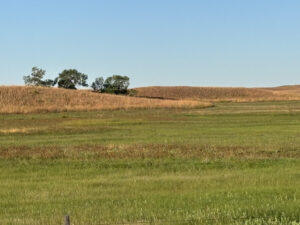
-
Nebraska grasses and fields.
-
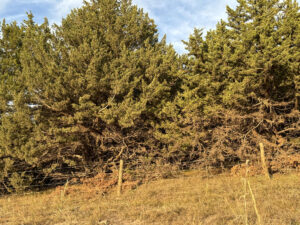
-
Fire spreads easily when branches touch
History
In 1902 University of Nebraska botanist Charlesy Bessey encouraged Forest Service Chief Gifford Pinchot and President Theodore Roosevelt to plant trees and create a forest in the grassy Sand Hills. The nation was facing a lumber shortage and most Americans valued forests over prairies and deserts, so they agreed.
Efforts
Millions of trees were planted close together over the 90,000-acre Bessey Unit. Many grew well; when we visited 30 years ago, they were mature and gorgeous.
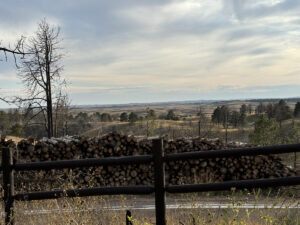
Rolling hills along the Loup River.
A fire tower was also built and staffed to watch for fires. Sure enough, fires broke out and killed many of the trees. Fire is an efficient sorter. Grass is highly fire-resistant. Many trees are not.
Return to Nebraska’s National Forest
Decades later we camped there again in September 2024 and were amazed at the change. Although the Forest Service Campground remains in trees, much of the former forest has quickly returned to grassland, due to several fires.
We saw thousands of dead trees with stacks of trunks piled along the road.
-
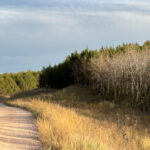
-
Grasses line a dirt road
-
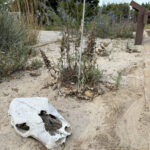
-
Nebraska’s grassland sandy soil.
-
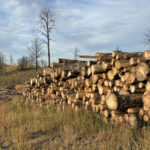
-
Recovering dead trees.
Lesson
Attempting to create a forest in a grassland was an ecological disaster. Over time nature is reclaiming land that should have been managed for what it is – healthy grass sprinkled with millions of wildflowers.
Continued Activity
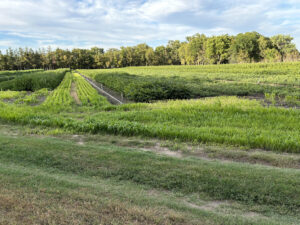
Trees grow in the nursery
The Bessey Unit includes a modern nursery where the Forest Service grows trees for replanting on land in the western United States. The surrounding land is a fascinating place to see first-hand the result of past management based on a misunderstanding of the environment.
The campground’s trees were spared fire and remain a shady place to camp for anyone driving across vast Nebraska. Great opportunities exist here for education and enjoyment of the trails. But, it needs maintenance. So does the now abandoned fire tower. For information check usda.gov/nebraska.
by Winding Pathways | Feb 29, 2024 | (Sub)Urban Homesteading, Home Improvements, Nature, Trees
Knot Just Lumber
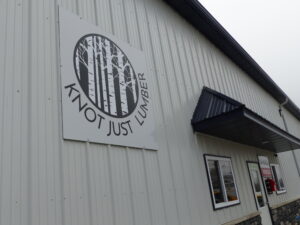
A local store
When driving through Hiawatha, Iowa, recently, a nondescript sign caught our eye. Posted on what looked like a warehouse the sign said, KNOT JUST LUMBER. We had to check it out and soon entered the ultimate wood candy store.
Leaning upright were immense slabs of white and red oak, walnut, cherry, and mulberry destined to become gorgeous tables. Nearby were smaller boards of at least a dozen tree species. Most were cut from native Iowa trees, but some racks held exotic wood from foreign lands. Purpleheart caught our eyes. It comes from trees that grow in Central and South America. When first cut the wood is dull grayish but within a few days, it transforms into an eggplant purple color.
Local Connections
We returned to visit Nic Carter, who co-owns the store with his sister, Caris. The family is from Alburnett and Nic was an active 4-H member dabbling in woods making jewelry boxes for art shows. After stints as a woodworker and home builder Nic, and his family opened Knot Just Lumber in September 2022. He and his sister decided to open the store because, “The area has no local woodworking place, so, I started one here,” he explained.
His father and son help run this family-owned and operated business located just north of Cedar Rapids. We enjoyed an in-person tour, which is augmented by their website and includes a virtual walk-through.
Knot Just Lumber caters to hobbyists, commercial customers, and families. We have visited several times and enjoyed chatting with individual customers and couples, and watched kids touch and smell the smooth, fragrant wood. The company buys trees from wood brokers. Most originate from trees in southern Iowa. The company mills wood into various-sized boards and turning rounds, dries it in an onsite kiln, surface planes, and sands most boards.
Wood is Special
Wood is special. We’ve noticed that in many brand-new houses doors, window frames, and floors are crafted from composite materials and plastic.
Nothing seems natural. In contrast, our 1947-era house has floors of Douglas Fir and White Oak with our furniture crafted from solid oak, pine, walnut, and cedar. Different woods make our home feel closer to nature while gracing us with the individual vibrant colors, textures, and grain patterns of each species. The woods connect us to woodworkers, friends, and craftspeople from bygone and current eras.
Commercial Lumber
Commercial lumber is usually cut from the straightest and most uniform trees. Buy it from a large commercial outlet and it’s attractive and easy to work but lacks the character implanted in wood by knots and irregular growth. In contrast, every wood slab we saw at Knot Just Lumber showed the individuality and character of the tree that created it. “Some of the most interesting wood comes from trees that grew in urban areas where their branches spread widely. It helps give the wood wonderful character and beautiful grain,” said Nic.
Unfortunately, every year millions of trees, many growing in towns, are felled after they die. Beautiful wood inside the bark is frequently hauled to a landfill, ground into shavings, or cut for firewood. Knot Just Lumber converts old veteran trees into lumber destined to be crafted into furniture that endures for generations. The company even saves sawdust and compresses it into briquettes to feed a wood stove or campfire. We bought some and found that they work wonderfully. We appreciated Nic’s caution that they do burn hot, so we use them sparingly. We are excited to use them with our occasional campfires out back.
-
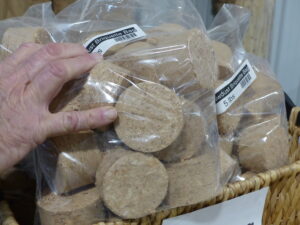
-
Value added and no waste.
-
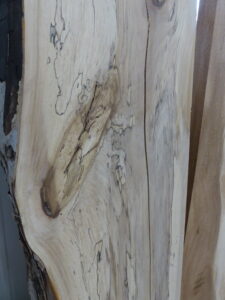
-
Fungi-laced wood
A Way to Add Character to a Room
The materials from our recent downstairs bathroom renovation are mostly manmade. That’s understandable, as the surfaces need to be easily cleaned and resist moisture. But the room needed the character of wood. So, we bought an oak board from Knot Just Lumber to cover a small area of plaster. It adds the warmth of nature to an otherwise utilitarian space.
Hidden Gems
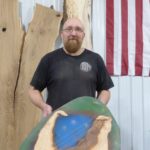
Fusing old and new technology.
Knot Just Lumber is a local store we found by accident. The staff consult, have working spaces and classes for customers and specialize in epoxy with the wood to create gorgeous pieces for homes. Their prices are reasonable, especially compared to national stores or online sources. Similar local stores are scattered across the country. Finding them can be tricky but hobbyist woodworkers know where they are and anyone can Google hardwood lumber and they might learn of a nearby place to buy gorgeous local wood.
Resources
One of our favorite resources to learn the diverse characteristics of dozens of different species of native and exotic woods is the book WOOD! Identifying and Using Hundreds of Woods Worldwide, by Eric Meier.
-
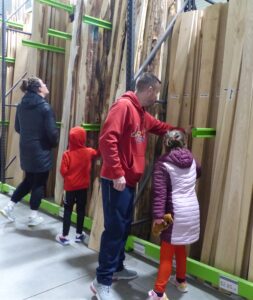
-
Families taking in the lumber.
-
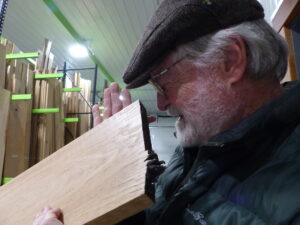
-
Assessing lumber.
-
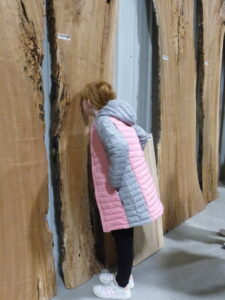
-
wood has a characteristic smell.
by Winding Pathways | Aug 10, 2023 | Mammals, Nature, Trees/Shrubs
Squirrels: Free Tree Planters
Our neighborhood squirrels proved they are the best tree planters.
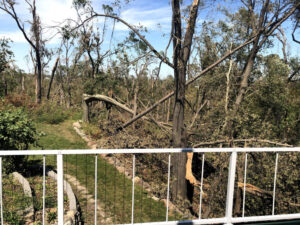
We lost most of our mature trees in the 2020 Derecho.
An August 2020 derecho tore through Iowa pushing 140-mile-an-hour wind against trees and buildings. Trees by the hundreds of thousands tumbled to the ground. Winding Pathways wasn’t spared. We lost most of our firs, oaks, hickories, and cottonwoods. The devastation in nearby Faulkes Heritage Woods was even worse.
Almost immediately, shocked people took action. Government forestry departments, aided by tree planting nonprofits, and private citizens unleashed their shovels and planted thousands of trees. So did the squirrels. Well, not really. People planted trees.
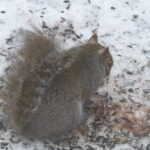
Squirrels bury nuts in caches to retrieve them later.
Squirrels planted nuts and acorns.
Then three seasons of drought followed. Once planted, most trees were not tended as they need to be. So, many human-planted trees shriveled in the heat and dryness, while the nuts buried by squirrels sprouted and the new trees were flourishing.
But why?
We have theories. A human-planted tree seedling needs plenty of moisture to keep its trunk and new leaves hydrated. Sparse roots must pull water from the ground and send it upward. That’s a tough job in a wet year. Come drought it’s nearly impossible.
Squirrels did better. These industrious rodents don’t mean to create new trees. They’re simply storing nuts underground so they have enough fat and protein-rich food to tide them through winter. All they need to do is dig up a nut when hunger calls. Squirrels overfill their larder, burying more tasty nuts than they’ll ever need. Unfortunate squirrels are eaten by hawks, foxes, owls, or humans, but the nuts they’d buried remain patiently waiting for spring’s warmth to germinate.
Sprouting nuts grow roots able to pull scarce moisture from the soil and send it to new baby leaves poking through the ground.
As we walked through July 2023’s dry woods we sadly see human-planted trees shriveled up and dead, while nearby a new generation of tiny walnut, oak, and hickories is rising from nuts planted by industrious squirrels.
-
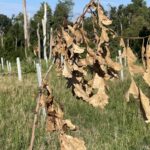
-
Newly planted trees need watering.
-
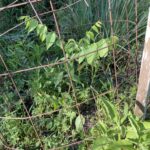
-
This squirrel planted walnut seedling sprouted just this year in spite of the drought.
Squirrels Don’t Plant All The Trees
Squirrels are the best friends of nut-bearing trees, but other tree species can’t rely on the furry rodents. Cottonwoods, for example, produce millions of seeds too tiny for squirrel food. So, the trees grow cottony fluff that floats seeds to distant places. If one lands in a patch of moist bear soil a fast-growing cottonwood sprouts. Maples have helicopter-like seeds that whirl a gig away from the parent to sprout a ways away.
Pity the poor Osage Orange tree that grows huge citrus-smelling balls containing hidden seeds. Many folks call them hedge apples. A tree must get its seeds away from its own shade. Squirrels do the job for oaks. The wind for cottonwoods. Massive mastodons once munched on Osage Orange hedge apples, wandered off, digested the pulp, and pooped out the seeds. When these massive elephants went extinct the tree lost its partner and saw its native range shrink from much of North America to a tiny spot down south.
Nature provides many ways for trees to reproduce and the results are often superior to what humans can do. We appreciate the squirrels that plant nuts many of which sprout into healthy native trees. Thanks, squirrels!
by Winding Pathways | Jan 12, 2023 | Nature, Trees
Winter trees. We love ‘em even though they don’t sport their cooling green summer leaves or October’s color.
When autumn leaves fall, trees look wonderfully different. Their nakedness reveals sights that are difficult to notice during summer. Here are some of the delights we discover when walking through January woodlands and looking at the winter trees.
Pods, Seeds, Textures
Pods and Seeds: Just what are those long string bean-looking pods hanging from the branches? They are the seed pods of the catalpa tree. Nearby are flattish, twisted, crinkled black pods upwards of six inches long. Some are still hanging from branches, while others litter the path. They’re honey locust pods. Pry one open to find large black seeds inside. Box elders have typical maple helicopter seeds that stay on the trees much of the winter unless devoured by hungry squirrels or cardinals. Sycamore trees hold their round ball seeds on the ends of branches well into winter.
Twig Texture: Elms and sugar maples sport zillions of finely textured twigs toward their tops, while walnuts, box elders, catalpas, and ailanthus have far fewer but much thicker twigs. Ash trees are somewhat in between, but their twigs radiate out at nearly right angles from branches.
-
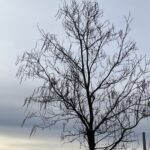
-
Catalpa pods hang on through the winter.
-
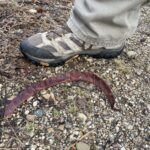
-
Pod next to size 12 foot.
-
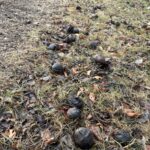
-
When you see walnuts look up and note the structure of the tree.
-
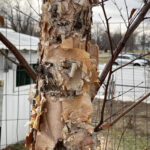
-
River Birch bark curls.
Bark and Shape
Bark: Young maples, ailanthus, and Siberian elms have smooth bark that becomes darker and more textured as the tree grows. The most intriguing bark pattern is always on hackberry trees. The bumpy bark makes it unmistakable.
Shape: The profile of leafless trees often is a clue to the species. Pin oaks have a central trunk with lower branches that sometimes slope downward or radiate out at nearly right angles. The tree is spruce shaped in great contrast to wide-spreading white and bur oaks. Box elders always seem to be leaning one way or another, while American elms often show a thick buttress close to the ground beneath a vase-shaped upper. Siberian elms shoot straight for the sky.
-
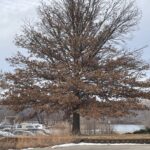
-
Pin oaks hold leaves.
-
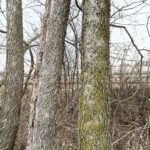
-
The knobby bark of the Hackberry reminds us of fat tires!
-
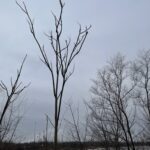
-
Ailanthus coarse twigs and finer twigging of Siberian Elm
Color
Color: Although winter tree bark is mostly gray to black sometimes color comes through. Spot a subtle orange bark and it’s likely a mulberry tree. Large Scotch pines also have pumpkin-colored bark towards the top. Sycamores are distinctive in their pale, flakey bark. And, white birches are easy to identify with their smoother, white bark that tends to curl as the trees age. Their cousin, the river birch, has shaggier bark and often grows larger in damp soil.
Winter trees are always fun to see and often are easy to identify. As we walk through the snow, we love discovering many tree shapes, textures, seeds, and bark. to help identify Google something like shape of (name of tree) in winter. The images will help you identify the trees before you go for a walk.
by Winding Pathways | Jun 9, 2022 | Nature, Trees
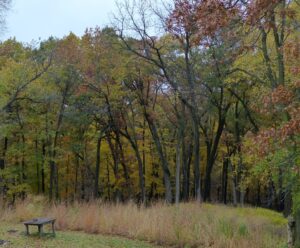
Harvesting Iowa Wood is sustainable.
When we tell people that Iowa is a major producer of some of the world’s most beautiful hardwood, they think we’re nuts. After all, we live in the corn state, where it’s possible to drive a hundred miles viewing only crops.
“Iowa is the sweet spot for the highest quality walnut lumber. Further north it’s too cold for the trees to get big enough and down south they grow so fast the logs contain much white sapwood and wide growth rings. Local walnut is of the highest quality, and it’s beautiful and abundant,” said Thomas Hunt as he led us through the Kendrick Forest Products Mill in Edgewood, Iowa.
Black walnut has been a favored hardwood for paneling, cabinetry, furniture, and gunstocks for hundreds of years. Its dark heartwood has a complex grain pattern that glistens with beauty. It is easy to work with, holds finish well, and is used to create furniture prized for generations.
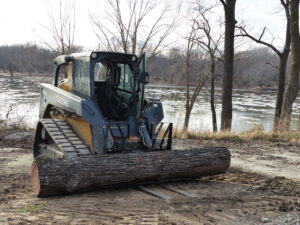
Log ready to be loaded.
Walnut trees are abundant in Iowa, especially in the tightly wooded valleys of the Driftless Area. Trees grow relatively quickly and produce annual nut crops that squirrels bury by the thousands each fall. They only find some for winter snacks. The rest sprout into new trees. When carefully logged walnuts, along with oaks, hickories, ashes, and basswoods produce crops at long intervals and just as sustainably as well-managed farm crops.
Logs are shipped to Kendrick’s mill and sorted by species. During our visit, workers were transforming sugar maple logs into boards. No doubt some will end up flooring beautiful and resilient basketball courts.
Logs enter a huge machine that removes the bark and any dirt clinging to it. They then enter a powerful bandsaw. We watched Zippy operate hand and foot controls that fed each log into the blade that squared off a side. He then flipped it over and cut three more times to create a massive squared-off hunk of maple that next moved to another saw. It cuts the log into one of many things. Sometimes they make railroad ties. We watched the saw create inch-thick lumber.
Boards then go to the “green chain”, a room where workers sort them by grade and stack them up. From there they are cured in the open air and eventually in a kiln that removes moisture.
Finished products are shipped to customers far and wide. Walnut is especially valued overseas. Anyone who loves finely-crafted cabinetry, paneling, or flooring may have Iowa-grown wood processed at Kendrick Forest Products. Iowa’s more than a corn state!
Want to see the mill in action? Kendrick’s offers tours. Information is on their website at kfpiowa.com/take-a-tour/. Can’t get to Eldridge? Enjoy a video tour on their website. And, learn about Monday Mulch!



























